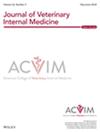Pain Assessment of Horses With Trigeminal-Mediated Headshaking (TMHS) at Rest Between Episodes
Abstract
Background
While there is agreement that horses experience pain during the actual headshaking attacks, there is still a lack of research about the time between the individual episodes in this species.
Objectives
To evaluate the signs of pain in horses with TMHS at rest in the absence of common triggering factors.
Animals
Twenty TMHS horses (not head shaking at the time of pain assessment), 20 horses with colic, and 20 clinically healthy horses.
Methods
Descriptive study assessing pain in TMHS horses during the absence of clinical signs using the Horse Grimace scale (HGS). To grade the pain shown with TMHS, horses with moderate gastrointestinal pain conditions and a healthy horses' group were also included. For evaluation, videos were taken on two consecutive days from both sides of the face (healthy, TMHS) or before analgesics were applied (colic). Eight photos per horse were extracted from the videos, randomized, and evaluated by three examiner groups, each comprising two persons: (a) last-year veterinary medicine students without previous use of the HGS, (b) experienced veterinarians without experience in using the HGS, and (c) experienced veterinarians who regularly apply the HGS. All examiners were blinded to the underlying condition.
Results
Median HGS scores in the groups (healthy, gastrointestinal, TMHS) differed significantly from each other (p < 0.05). Healthy horses had median HGS scores below 2 (median 1.2, range: 0.1–2.4), whereas TMHS horses had higher median HGS scores (5.6, range 2.4–7.4), and colic horses had the highest HGS scores (6.6, range: 3.8–8.4). There was a statistically significant difference for all facial action units (FAU) when the different horse groups were compared (p < 0.05). Effect sizes were large for the healthy horses' group (ES-1.23) and for the colic horses (ES 0.86), and small to medium for the TMHS horses (ES 0.37).
Clinical Importance
The results of this study show that pain occurs between individual TMHS attacks in severely affected horses and that the quality of life of these horses must be questioned and evaluated individually.


 求助内容:
求助内容: 应助结果提醒方式:
应助结果提醒方式:


